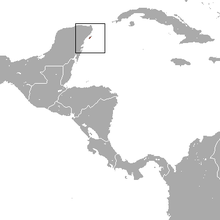Cozumel coati
| Cozumel Island coati | |
|---|---|
| Scientific classification | |
| Domain: | Eukaryota |
| Kingdom: | Animalia |
| Phylum: | Chordata |
| Class: | Mammalia |
| Order: | Carnivora |
| Family: | Procyonidae |
| Genus: | Nasua |
| Species: | |
| Subspecies: | N. n. nelsoni
|
| Trinomial name | |
| Nasua narica nelsoni Merriam, 1901
| |

| |
| Cozumel Island coati range | |



The Cozumel Island coati (Nasua narica nelsoni) is a coati from the Mexican island of Cozumel. It is in the family Procyonidae, which also includes raccoons, olingos, and kinkajous. It has been treated as a species, but the vast majority of recent authorities treat it as a subspecies of the white-nosed coati.[1][2][3][4] Cozumel Island coatis are slightly smaller than the white-nosed coatis of the adjacent mainland (N. n. yucatanica); but, when compared more widely to white-nosed coatis, the difference in size is not as clear.[5] The level of other differences also support its status as a subspecies rather than a separate species.[5]
It has been speculated that it is the result of an ancient introduction to Cozumel by the Mayans.[6] Although not rated by the IUCN (where included in the widespread white-nosed coati),[4] it is believed that the Cozumel Island coati is highly threatened and close to extinction.[7]
References
- ^ Wozencraft, W. C. (2005). "Order Carnivora". In Wilson, D. E.; Reeder, D. M. (eds.). Mammal Species of the World: A Taxonomic and Geographic Reference (3rd ed.). Johns Hopkins University Press. pp. 625–626. ISBN 978-0-8018-8221-0. OCLC 62265494.
- ^ Kays, R. (2009). White-nosed Coati (Nasua narica), pp. 527-528 in: Wilson, D. E., and R. A. Mittermeier, eds. (2009). Handbook of the Mammals of the World. Vol. 1, Carnivores. ISBN 978-84-96553-49-1
- ^ Reid, Fiona A. (1997). A Field Guide to the Mammals of Central America and Southeast Mexico. pp. 259–260. ISBN 0-19-506400-3. OCLC 34633350.
- ^ a b Samudio, R.; Kays, R.; Cuarón, A.D.; Pino, J.L.; Helgen, K. (2008). "Nasua narica". IUCN Red List of Threatened Species. 2008. Retrieved 6 May 2012.
{{cite journal}}: Invalid|ref=harv(help); Unknown parameter|last-author-amp=ignored (|name-list-style=suggested) (help) - ^ a b Decker, D. M. (1991). Systematics Of The Coatis, Genus Nasua (Mammalia, Procyonidae) Archived 2014-10-06 at the Wayback Machine. Proceedings of the Biological Society of Washington 104: 370-386
- ^ Nowak, R., eds. (1999). Walker's Mammals of the World. Vol. 1, p. 700. Baltimore, Maryland: The Johns Hopkins University Press University Press. ISBN 0-8018-5789-9
- ^ McFadden, K. W.; García-Vasco. D.; Cuarón, A. D.; Valenzuela-Galván, D.; Medellín, R. A.; Gompper, M. E. (2009-08-15). "Vulnerable island carnivores: the endangered endemic dwarf procyonids from Cozumel Island" (PDF). Biodiversity and Conservation. 19 (2): 491–502. doi:10.1007/s10531-009-9701-8. Archived from the original (PDF) on 2010-06-25. Retrieved 2012-05-06.
External links
 Data related to Nasua narica nelsoni
Data related to Nasua narica nelsoni
(Cozumel Island coati) at Wikispecies
